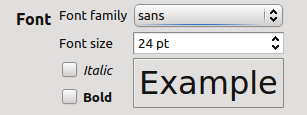Text
How can I present text?
The most common way to show text is using a sketchpad or feedback item. These allow you to enter text and other visual stimuli. For a questionnaire-like way to show text, you can use forms.
HTML formatting
You can use a HTML tags, which you can simply insert into your text. You can use these tags everywhere: In sketchpad items, in inline_scripts (provided you use the Canvas class), in forms, etc.
Example:
OpenSesame supports a sub-set of HTML tags:
- <b>Bold face</b>
- <i>Italic</i>
- <u>Underline</u>
In addition, you can pass 'color', 'size', and 'style' as keywords to a 'span' tag:
- <span style='color:red;'>Color</span>
- <span style='font-size:32px;'>Font size</span>
- <span style='font-family:serif;'>Font style</span>
Finally, you can force newlines with the 'br' tag:
Line 1<br>Line 2
Variables and inline Python
You can embed variables in text using the {...} syntax. For example, the following:
The subject number is {subject_nr}
... might evaluate to (for subject 1):
The subject number is 1
You can also embed Python expression. For example, the following:
The subject number modulo five is {subject_nr % 5}
... might evaluate to (for subject 7)
The subject number modulo five is 2
Fonts
Default fonts
You can select one of the default fonts from the font-selection dialogs (Figure 1). These fonts are included with OpenSesame and your experiment will therefore be fully portable when you use them.

Figure 1. A number of default fonts, which are bundled with OpenSesame, can be selected through the font-selection dialogs.
The fonts have been renamed for clarity, but correspond to the following open-source fonts:
| Name in OpenSesame | Actual font |
|---|---|
sans |
Droid Sans |
serif |
Droid Serif |
mono |
Droid Sans Mono |
chinese-japanese-korean |
WenQuanYi Micro Hei |
arabic |
Droid Arabic Naskh |
hebrew |
Droid Sans Hebrew |
hindi |
Lohit Hindi |
Selecting a custom font through the font-selection dialog
If you select 'other ...' in the font selection dialog, you can select any font that is available on your operating system. If you do this, your experiment is no longer fully portable, and will require that the selected font is installed on the system that you run your experiment on.
This is only works for OpenSesame on the desktop, not for online OSWeb experiments.
Placing a custom font in the file pool (OpenSesame desktop)
When running your experiment on the desktop, another way to use a custom font is to put a font file in the file pool. For example, if you place the font file inconsolata.ttf in the file pool, you can use this font in a sketchpad item, like so:
draw textline 0.0 0.0 "This will be inconsolata" font_family="inconsolata"
The font file must be a truetype .ttf file. This is only works for OpenSesame on the desktop, not for online OSWeb experiments.
Using a custom font from Google Fonts (OSWeb)
When running your experiment in a browser with OSWeb, you can use fonts from Google Fonts. To do so, simply edit the script of a text element and specify the name of the font under font_family:
draw textline x=0 y=0 font_family="Jacquard 12 Charted" text="This is shown in a funny font"
This is only works for online OSWeb experiments, not for OpenSesame on the desktop.


